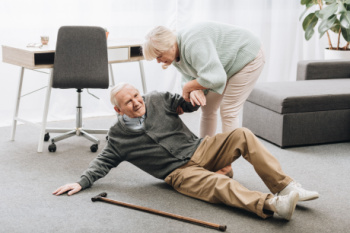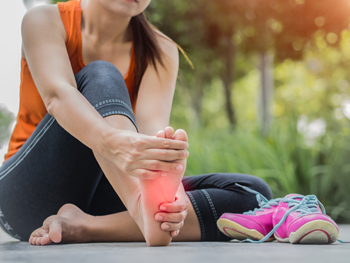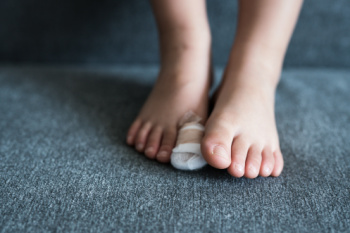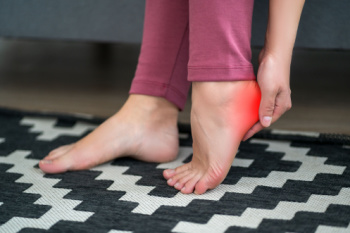Items filtered by date: March 2024
Reminder: When Was the Last Time...?
Preventing Falls and Protecting Home Safety With Smoke Alarms

Home safety is important for everyone, particularly the elderly and children who are more susceptible to falls. Taking proactive measures can significantly reduce the risk of accidents and falls within the household. One vital aspect of home safety is the installation and maintenance of smoke alarms. These devices serve as early warning systems, alerting occupants to the presence of smoke or fire and providing valuable time to evacuate safely. In addition to smoke alarms, several other measures can help prevent falls and enhance overall home safety. These include securing rugs and carpets to prevent tripping hazards, ensuring adequate lighting in hallways and staircases, and installing handrails in bathrooms and along staircases for added support. Clearing clutter and keeping walkways free from obstacles also contribute to a safer living environment. By prioritizing home safety and implementing preventive measures, individuals can protect their feet from the injuries that falling can cause. If you are seeking additional information about effective fall prevention techniques, it is suggested that you confer with a podiatrist.
Preventing falls among the elderly is very important. If you are older and have fallen or fear that you are prone to falling, consult with Philip Hahn, DPM from Advanced Foot & Ankle Center. Our doctor will assess your condition and provide you with quality advice and care.
Every 11 seconds, an elderly American is being treated in an emergency room for a fall related injury. Falls are the leading cause of head and hip injuries for those 65 and older. Due to decreases in strength, balance, senses, and lack of awareness, elderly persons are very susceptible to falling. Thankfully, there are a number of things older persons can do to prevent falls.
How to Prevent Falls
Some effective methods that older persons can do to prevent falls include:
- Enrolling in strength and balance exercise program to increase balance and strength
- Periodically having your sight and hearing checked
- Discuss any medications you have with a doctor to see if it increases the risk of falling
- Clearing the house of falling hazards and installing devices like grab bars and railings
- Utilizing a walker or cane
- Wearing shoes that provide good support and cushioning
- Talking to family members about falling and increasing awareness
Falling can be a traumatic and embarrassing experience for elderly persons; this can make them less willing to leave the house, and less willing to talk to someone about their fears of falling. Doing such things, however, will increase the likelihood of tripping or losing one’s balance. Knowing the causes of falling and how to prevent them is the best way to mitigate the risk of serious injury.
If you have any questions, please feel free to contact our office located in Texarkana, TX . We offer the newest diagnostic and treatment technologies for all your foot care needs.
Injury Prevention for Runners

All runners are susceptible to a range of foot injuries stemming from the repetitive nature of running and other factors. Neglecting flexibility training can lead to decreased range of motion and increased risk of injuries such as strains and tears. Cross-training, incorporating activities like swimming or cycling, can mitigate these risks by engaging different muscle groups and reducing overuse injuries. Additionally, a balanced approach to fitness will help prevent foot injuries. Podiatrists play a significant role in this respect, offering expertise in foot and lower limb biomechanics, gait analysis, and injury prevention. They can guide proper footwear selection, orthotic devices, and personalized exercise regimens to address individual needs and reduce injury risk. If you are a runner, it is suggested that you make an appointment with a podiatrist to learn more about injury prevention in running so you can enjoy this port for the long term.
All runners should take extra precaution when trying to avoid injury. If you have any concerns about your feet, contact Philip Hahn, DPM of Advanced Foot & Ankle Center. Our doctor will treat your foot and ankle needs.
How to Prevent Running Injuries
There are a lot of mistakes a runner can make prior to a workout that can induce injury. A lot of athletes tend to overstretch before running, instead of saving those workouts for a post-run routine. Deep lunges and hand-to-toe hamstring pulls should be performed after a workout instead of during a warmup. Another common mistake is jumping into an intense routine before your body is physically prepared for it. You should try to ease your way into long-distance running instead of forcing yourself to rush into it.
More Tips for Preventing Injury
- Incorporate Strength Training into Workouts - This will help improve the body’s overall athleticism
- Improve and Maintain Your Flexibility – Stretching everyday will help improve overall performance
- “Warm Up” Before Running and “Cool Down” Afterward – A warm up of 5-10 minutes helps get rid of lactic acid in the muscles and prevents delayed muscle soreness
- Cross-Training is Crucial
- Wear Proper Running Shoes
- Have a Formal Gait Analysis – Poor biomechanics can easily cause injury
If you have any questions, please feel free to contact our office located in Texarkana, TX . We offer the newest diagnostic and treatment technologies for all your foot care needs.
Types and Considerations of Toe Fractures

Toe fractures, though often considered minor injuries, can cause significant discomfort and hinder mobility. There are several types of toe fractures, each with its own characteristics and treatment considerations. A common type is a closed fracture, where the bone breaks but does not penetrate the skin. Open fractures occur when the broken bone pierces through the skin, increasing the risk of infection and requiring immediate medical attention. Stress fractures, caused by repetitive stress or overuse, are hairline cracks in the bone that may develop gradually over time. Another type is a displaced fracture, where the broken ends of the bone do not align properly, potentially requiring realignment through manipulation or surgery. Avulsion fractures involve the tearing away of a piece of bone where a tendon or ligament attaches. Regardless of the type of fracture, prompt evaluation by a podiatrist is suggested to determine the appropriate treatment approach and ensure optimal healing and recovery of the injured toe. If you have fractured your toe, it is strongly suggested that you confer with this type of doctor who can determine the type of fracture, and offer the treatment solution that is best for you.
Broken toes may cause a lot of pain and should be treated as soon as possible. If you have any concerns about your feet, contact Philip Hahn, DPM from Advanced Foot & Ankle Center. Our doctor will treat your foot and ankle needs.
What Is a Broken Toe?
A broken toe occurs when one or more of the toe bones of the foot are broken after an injury. Injuries such as stubbing your toe or dropping a heavy object on it may cause a toe fracture.
Symptoms of a Broken Toe
- Swelling
- Pain (with/without wearing shoes)
- Stiffness
- Nail Injury
Although the injured toe should be monitored daily, it is especially important to have a podiatrist look at your toe if you have severe symptoms. Some of these symptoms include worsening or new pain that is not relieved with medication, sores, redness, or open wounds near the toe.
If you have any questions, please feel free to contact our office located in Texarkana, TX . We offer the newest diagnostic and treatment technologies for all your foot care needs.
Are Heel Spurs Causing My Heel Pain?
 Heel spurs, bony outgrowths that develop on the underside of the heel bone, can cause heel pain when they rub against the soft tissues of your feet. Heel spurs do not usually cause pain. Pain typically comes about when the spurs press against or irritate the plantar fascia, a band of tissue that runs along the bottom of the foot. People with plantar fasciitis are more prone to developing heel spurs due to chronic inflammation. The pain associated with heel spurs is typically most pronounced during the first steps in the morning or after prolonged periods of rest. Treatment for heel spurs may include stretching exercises, orthotic inserts, or other interventions to alleviate discomfort associated with heel spurs and promote overall foot health. If you are experiencing heel pain or heel spurs, it is suggested you consult with a podiatrist for an accurate diagnosis and appropriate treatment plan.
Heel spurs, bony outgrowths that develop on the underside of the heel bone, can cause heel pain when they rub against the soft tissues of your feet. Heel spurs do not usually cause pain. Pain typically comes about when the spurs press against or irritate the plantar fascia, a band of tissue that runs along the bottom of the foot. People with plantar fasciitis are more prone to developing heel spurs due to chronic inflammation. The pain associated with heel spurs is typically most pronounced during the first steps in the morning or after prolonged periods of rest. Treatment for heel spurs may include stretching exercises, orthotic inserts, or other interventions to alleviate discomfort associated with heel spurs and promote overall foot health. If you are experiencing heel pain or heel spurs, it is suggested you consult with a podiatrist for an accurate diagnosis and appropriate treatment plan.
Many people suffer from bouts of heel pain. For more information, contact Philip Hahn, DPM of Advanced Foot & Ankle Center. Our doctor can provide the care you need to keep you pain-free and on your feet.
Causes of Heel Pain
Heel pain is often associated with plantar fasciitis. The plantar fascia is a band of tissues that extends along the bottom of the foot. A rip or tear in this ligament can cause inflammation of the tissue.
Achilles tendonitis is another cause of heel pain. Inflammation of the Achilles tendon will cause pain from fractures and muscle tearing. Lack of flexibility is also another symptom.
Heel spurs are another cause of pain. When the tissues of the plantar fascia undergo a great deal of stress, it can lead to ligament separation from the heel bone, causing heel spurs.
Why Might Heel Pain Occur?
- Wearing ill-fitting shoes
- Wearing non-supportive shoes
- Weight change
- Excessive running
Treatments
Heel pain should be treated as soon as possible for immediate results. Keeping your feet in a stress-free environment will help. If you suffer from Achilles tendonitis or plantar fasciitis, applying ice will reduce the swelling. Stretching before an exercise like running will help the muscles. Using all these tips will help make heel pain a condition of the past.
If you have any questions please contact our office located in Texarkana, TX . We offer the newest diagnostic and treatment technologies for all your foot and ankle needs.





